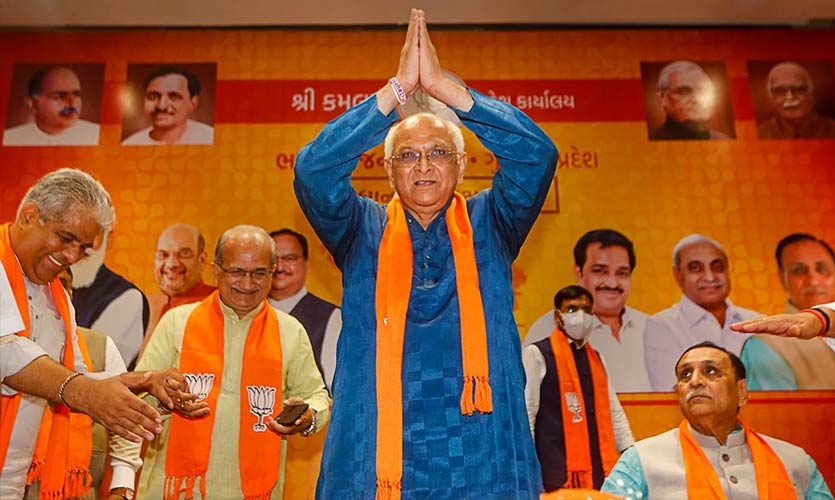In a sudden move, Vijay Rupani became the fourteenth chief minister to resign from the post in Gujarat, also joining the tally of other CMs who have stepped down in BJP ruled states. B.S. Yediyurappa in Karnataka and two Uttarakhand chief ministers – Tirath Singh Rawat and Trivendra Rawat – also resigned this year.
Rupani’s announcement on Saturday that he has decided to resign as the Gujarat CM saying this is an “opportunity” for the party’s new leadership to take over, came amidst rumours of his exit that had already been clouding Gujarat’s political environment since a few days.
His exit from office was overdue after his handling of the second wave of COVID-19 and his administrative style upset the central leadership. Rupani’s departure from office came without a customary summons to Delhi, meetings with the top leadership and without a talk on his performance.
The party seems to have made an unavoidable move, effortlessly switching to a new CM within 24 hours, without any political trouble. The opposition in the state also appeared to be bystanders.
While social media flooded with images of all the probable or improbable names for who could be the next CM of Gujarat, the nomination of Bhupendra Patel, a one-time MLA, surprised almost everyone.
Reportedly, Bhupendra Patel came into PM Modi’s good books when the latter was the CM of Gujarat, and Patel had taken over as chairman of the standing committee of Ahmedabad Urban Development Authority (AUDA). Patel had implemented the then-CM’s vision of development of Ahmedabad by constructing bridges, and redeveloping and beautifying the city. Patel, an engineer by profession and a protégé of former Gujarat CM Anandiben Patel, does not have any known blemishes on his political career. This could also be one of the reasons behind his appointment as Gujarat’s 17th chief minister.
The decision to not appoint Nitin Patel as Rupani’s successor is the only one with the possibility of creating chaos within the party. Nitin Patel has had a long political career. Being a six time MLA and the Deputy Chief Minister of Gujarat made him a strong candidate. Responding to reporters on Monday, the outgoing deputy CM turned teary-eyed and said he is in “debt” of the people who supported him throughout.
“I am a representative of Mehsana – I am a two-term MLA from here. I had four terms as an MLA from Kadi. So, I am a six-term MLA and with the blessings of the voters of Kadi and Mehsana and also the party workers who supported me… whoever has made me what I am today, I am accepting the debt I owe them for their support. It is in my principles (sanskaar) and that is what I have said,” said Nitin Patel.
Bhupendra Patel’s appointment as the new CM also manifests the BJP’s agenda to control the damage caused during the two waves of COVID-19, and to win over the Patidar community who constitutes nearly 14 percent of the state’s population. His appointment is a message to this powerful and politically volatile community, which could benefit the BJP in next year’s assembly election.
During the previous election, when there was a strong Patidar agitation for reservation led by Hardik Patel, the BJP had adopted an iron fist approach to crush the agitation and snatched the majority by seven seats to bag 99 in the 182-member assembly.
“Till 2012, one-fourth of the BJP’s 48% votes polled came from the Patels. Despite the anger among the Patidars and their quota agitation of 2015, the BJP brought in 99 MLAs and one-third of these were from the caste. To keep the Patidars happy, the BJP gave 7 hefty portfolios and the deputy chief minister’s post to the Patels,” explains India Today.
Bhupendra Patel’s name appeared to be the most righteous one in the move to appease the Patidar community and benefit the party.
The Patidar bloc contains two factions – the Kadva Patidar, a community that forms 30 percent of the whole Patel vote – and the Leuva Patels, forming 70 percent of the caste. The agitation of 2015 was primarily led by the Kadva Patidars who demanded more share of power in the government and expressed their unhappiness with the appointment of the four Patidar CMs in the past, each of whom was from the Leuva Patidar sub-group.
Read more: All You Need To Know About The Centre’s Cabinet Reshuffle
Nitin Patel is also a Kadva Patidar, however, according to feedbacks received by the BJP, despite his strong candidacy he does not have deep associations within the community. Reportedly, the party also did not want to upset other senior party members in Gujarat who could have created factionalism within the party if he would have been handed the post of chief minister.
Bhupendra Patel’s appointment as CM indicates the key role of electoral arithmetic to woo voters from the Patidar bloc and to win back its support ahead of the 2022 assembly election.
It is too early to predict any outcomes especially when other parties such as the AAP have also made huge inroads into Gujarat’s socio-political atmosphere. This development will surely have an impact on the coming election. But whether it will favour the BJP or not, only time will tell.










